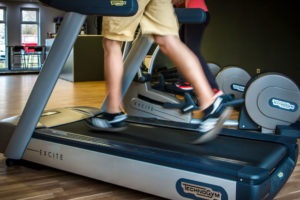Optimise your training by knowing the relative merits of treadmill running and outdoor running!
There are conflicting opinions as to whether running on a treadmill is similar to running outside, in terms of biomechanics. Outside, your legs have to propel themselves forward as opposed to having to pick up your feet on a treadmill, as a belt slides underneath. There is also no wind resistance and the climate is controlled. However, there is some scientific research to suggest that running on a treadmill at a 1% grade may relatively accurately reflect the energy spent running to simulate an outdoor running technique[1]; so running on a treadmill might not be a bad option for simulating outdoor conditions when set up in this way.
Treadmill training can be great in adverse weather conditions to maintain training. Furthermore, rehabilitation from an injury can be carefully paced back on a treadmill. The surface can be more yielding. Using a mirror as feedback can also help work on “form” issues which might contribute to running injuries – such as running with one elbow slightly higher, or knees which “collapse” inwards due to proximal control or lower leg problems. Good treadmills can be programmed to simulate a course, or otherwise incline levels can be manually manipulated. Therefore, potentially, you can use a treadmill to really target areas of weakness in your running (such as hills, or declines) which need addressing.
The downsides of treadmill training are that it can be boring! Furthermore, it can be difficult to help you set your pacing over the course of a run. Lastly, in order for any skill to progress, the skill needs an appropriate degree of functional, “specific” training, which only outdoor running will achieve. The perturbations of the running surface, specific climate/conditions including wind resistance, stimulus and mental preparation involved in outdoor running are required at a certain minimum level of your training, to directly prepare and challenge your body (and brain!) for what is needed to successfully run an event.
So my final verdict? A combination of both treadmill and outdoor running can be a great means of mixing up training and targeting key areas for improvement. In the winter months, leading up to races towards the later part of the year, having an indoor option to keep up training is highly beneficial. Happy running!
[1] Jones AM, Doust JH (1996). ‘A 1% treadmill grade most accurately reflects the energetic cost of outdoor running’. J Sports Sci, 14(4):321-7.


